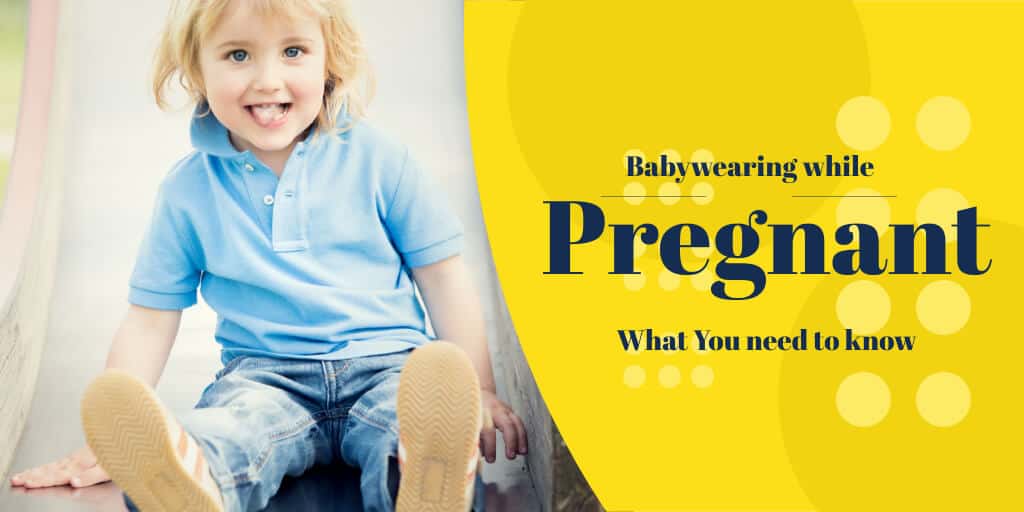Babywearing While Pregnant: What You need to know
You’re pregnant again. Congratulations!
Time to makes some changes. Say hello to pre-natal vitamins and goodbye to margaritas.
But you know what doesn’t have to change just because you’re pregnant? Wearing your baby. There is still a tremendous benefit to babywearing, even when you’re pregnant.
Now more than ever you need to have your hands free to get stuff done. You have to dust off the car seat, bring your newborn clothes up from the basement and figure out where the new baby is going to sleep.
Your toddler has become accustomed to being with you. In fact, you are most likely more connected to your child than ever because of all the babywearing you’ve been doing. But as your new baby grows in your belly, there are a few things to keep in mind when it comes to carrying your baby.
No products found.
1. You may need to alter the way you carry your baby.
There are many ways to babywearing while pregnant. In the early stages, it’s still possible to carry your child in front of your body and above your bump, but as you advance through your pregnancy, your ligaments will get looser due to the hormone relaxin. This may cause lower back pain and postural misalignment. So consider moving the child to a hip carrier. You could use a traditional ring sling or you could turn a wrap sling into a hip carrier. Check the video just below.
Towards the end of your pregnancy, you may not be able to carry your toddler on your hip anymore, but this is when carrying your baby on your back, is ideal. If you’re using a soft structured baby carrier like an Ergo baby carrier, try to tie the buckle above or under your belly, (see the images below).
There is a carrier to accommodate every stage of your pregnancy. Don’t be afraid to try something new.
2. Babywearing your toddler? First listen to what your body is telling you.
The little tyke inside your belly is pushing and pulling and changing all sorts of things about your body. It’s important not to ignore any feelings of discomfort, pain or fatigue. Also, any nausea, dizziness, and lightheadedness should be a red flag to stop immediately. Sometimes the weight of the baby or toddler being worn can be too much for the mother during the later stages of pregnancy. Pay attention to your body’s cues and ease up when necessary.
No products found.
3. Toddler Babywearing? This is not the time to hike the Appalachian Trail.
Stick with what you’ve been doing up to this point.
The body has an amazing memory. If you have been wearing your baby regularly over the last couple of years, your body knows just what to do. Your strength and stamina will increase accordingly with the new baby and you won’t need to miss a step. But if babywearing is new to you, start out slowly. Give your body time to adapt. Especially if you have a heavy toddler. Just like you wouldn’t want to start training for a marathon right now, don’t try any adventurous, new baby wearing maneuvers.
4. Common sense trumps all.
If your carrier feels comfortable and you feel good, you are doing something right. If something is uncomfortable or strained, stop and reassess. Remember, every pregnancy is different. What worked on your last pregnancy might not work with this one. The new baby has its own agenda. So more than ever, listen to what your body is telling you. Don’t overdo it.
Be sure to lift and tie your baby carrier correctly to protect your pelvis, ligaments, and back. Trust your instincts. After all, mom knows best.
5. Go easy at the end.
For some pregnant moms, there comes a point in every pregnancy when you don’t want to do a darn thing. You don’t want to rush to the bathroom one more time, or wake up snoring, or have one more intense leg cramp. When that time comes, you may also want to hang up your baby carrier and just spend the last few days (or weeks) on the sofa with a bag of Fritos and a DVD of “Downton Abbey.” Give yourself permission. Don’t worry, your baby carrier will be waiting for you when you return. And it will even help you lose all the baby weight.
But even if you decide to stop wearing your toddler, you can still use your baby carrier – if you’ve got a wrap, that is.
No products found.

